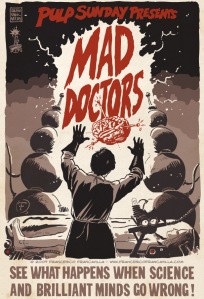Sourced from here
 Ghana’s chief psychiatrist, Dr Akwesi Osei, has made the startling announcement that his own psychiatric doctors, responsible for the mental health of the nation, are themselves suffering from mental disorders! He has not stated whether he has included himself in this diagnosis.
Ghana’s chief psychiatrist, Dr Akwesi Osei, has made the startling announcement that his own psychiatric doctors, responsible for the mental health of the nation, are themselves suffering from mental disorders! He has not stated whether he has included himself in this diagnosis.
Did he know these doctors were mad when they were employed, or have they become disordered under his administration? It is certainly a serious state of affairs especially for those who need treatment!
For those that may not know the background, there is currently civil unrest amongst many workers in Ghana over issues with salaries. Doctors are striking because of longstanding, unresolved pay disputes with the government.
Doctors additional allowances for all their extra hours were merged with their salaries onto a single spine salary structure (ssss) – the 3rd salary structure doctors have been moved onto. The merging of salaries with allowances has resulted in less pay which has in turn affected pensions. Despite what the government promised, they unilaterally changed the deal in contravention of the Labour Act 2003. Let’s not forget government ministers have increased their own salaries and receive endless allowances!
Teachers have also been battling with salary discrepancies since 2010!
It spite of these clear injustices, Dr Osei has stated to the media that all labour disturbances are a sign of mental disorder, which includes his own striking doctors!
 It was not so long ago that women were categorised as suffering from hysteria if they showed resistance to patriarchy.
It was not so long ago that women were categorised as suffering from hysteria if they showed resistance to patriarchy.
“Doctors had observed that hysterical women were resistant to or critical of marriage, and were believed to be strangely independent and assertive. While hysterical girls were viewed as closet feminists and rejecting traditional roles, likewise feminist activists were denigrated as hysterics, sick and abnormal women who did not represent their sex. By the 1880s, it had become common in England for the term ‘hysterical’ to be linked to feminist protests in newspapers and in the rhetoric of anti-suffragists.” – Paul Turnball
Does being healthy mean ‘shut up and put up’ and accept the status quo? Are workers supposed to accept the injustices of capitalism and to be labelled mentally disordered if they show resistance? Rather I would suggest it is a sign of a healthy person to resist injustice.
Dr Osei has also claimed that LGBT people suffer from mental disorders and therefore

should not qualify for human rights.
Even if we wish to accept his lone voice (standing in contradiction to international medical opinion) that LGBT people suffer from a mental disorder, is he now suggesting that all people with mental disorders should be denied human rights? Perhaps this attitude may account for the appalling treatment of many mentally ill people in Ghana as shown in Africa Review and the photoblog of Nyani Quarmyne.
Human Rights Watch has described the situation in Ghana as “appalling” and that:
“In psychiatric hospitals, people with mental disabilities face overcrowding and unsanitary conditions.”
When people make personal assertions, especially those which contradict scientific and medical research, we should demand evidence. Like all scientific research it should be peer reviewed and assessed. Personal opinions, particularly from those in positions of power, should remain personal or stated as such. When personal opinions appear to support elite interests, the position of neutrality we expect from doctors can appear compromised.
Ghana’s health professionals are doing a great job in caring for people. Mental health is still facing stigmatisation and cultural and religious misunderstandings. Our doctors need support from the state not penalisation and name calling. There is much education and work to be done.
